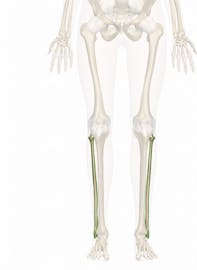The Fibula
Explore the anatomy and vital role of the fibula in supporting lower leg muscles with Innerbody's 3D model.

The fibula is the long, thin and lateral bone of the lower leg. It runs parallel to the tibia, or shin bone, and plays a significant role in stabilizing the ankle and supporting the muscles of the lower leg. Compared to the tibia, the fibula is about the same length, but is considerably thinner. The difference in thickness corresponds to the varying roles of the two bones; the tibia bears the body's weight from the knees to the ankles, while the fibula merely functions as a support for the tibia.
At the fibula's proximal end, just below the knee, is a slightly rounded enlargement known as the head of the fibula. The head of the fibula forms the proximal (superior) tibiofibular joint with the lateral edge of the tibia. From the proximal tibiofibular joint, the fibula extends slightly medially and anteriorly in a straight line toward the ankle. Upon reaching the ankle, the fibula swells into a bony knob known as the lateral malleolus, which can be seen and felt protruding from the outside of the ankle joint. At the medial malleolus, the fibula forms the distal (inferior) tibiofibular joint with the tibia and also the talocrural (ankle) joint with the tibia and talus of the foot.
While the fibula moves very little relative to the tibia, the joints that it forms contribute significantly to the function of the lower leg. The proximal and distal tibiofibular joints permit the fibula to adjust its position relative to the tibia, increasing the range of motion of the ankle. The lateral malleolus also forms the lateral wall of the talocrural joint and reinforces the ankle joint.
Many muscles of the thigh and lower leg attach to the fibula through tendons. One of the hamstrings, the biceps femoris muscle, has its insertion at the head of the fibula and pulls on the fibula to flex the leg at the knee. Eight other muscles --- including the three fibularis (peroneus) muscles, the soleus, and several flexors and extensors of the toes --- have their origins on the fibula as well.
An interesting fact about the fibula is that it can be harvested for tissue to graft onto other bones in the body. The fibula bears so little body weight that it typically has more bone mass than is needed to support the leg, making it a good tissue donor. The bony tissue harvested from the fibula is most commonly grafted onto the mandible to replace bone lost during oral cancer surgery. Skin and blood vessels covering the fibula are grafted along with the osseous (bone) tissue to maintain blood supply to the bone and to close the wound in the face. The remaining tissue in the leg can be sutured together to heal around the donor site.









